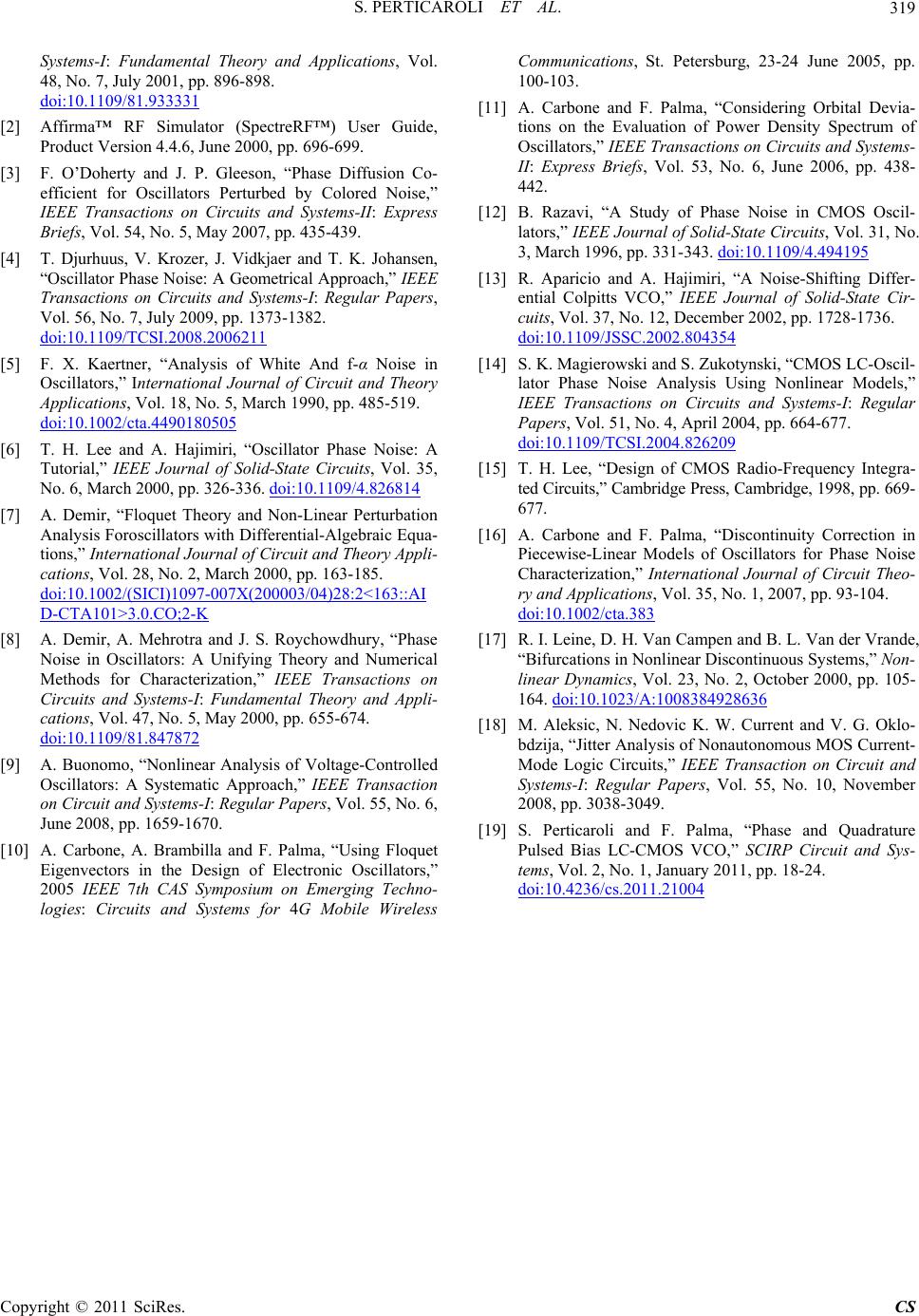
S. PERTICAROLI ET AL.
Copyright © 2011 SciRes. CS
319
Systems-I: Fundamental Theory and Applications, Vol.
48, No. 7, July 2001, pp. 896-898.
doi:10.1109/81.933331
[2] Affirma™ RF Simulator (SpectreRF™) User Guide,
Product Version 4.4.6, June 2000, pp. 696-699.
[3] F. O’Doherty and J. P. Gleeson, “Phase Diffusion Co-
efficient for Oscillators Perturbed by Colored Noise,”
IEEE Transactions on Circuits and Systems-II: Express
Briefs, Vol. 54, No. 5, May 2007, pp. 435-439.
[4] T. Djurhuus, V. Krozer, J. Vidkjaer and T. K. Johansen,
“Oscillator Phase Noise: A Geometrical Approach,” IEEE
Transactions on Circuits and Systems-I: Regular Papers,
Vol. 56, No. 7, July 2009, pp. 1373-1382.
doi:10.1109/TCSI.2008.2006211
[5] F. X. Kaertner, “Analysis of White And f-α Noise in
Oscillators,” International Journal of Circuit and Theory
Applications, Vol. 18, No. 5, March 1990, pp. 485-519.
doi:10.1002/cta.4490180505
[6] T. H. Lee and A. Hajimiri, “Oscillator Phase Noise: A
Tutorial,” IEEE Journal of Solid-State Circuits, Vol. 35,
No. 6, March 2000, pp. 326-336. doi:10.1109/4.826814
[7] A. Demir, “Floquet Theory and Non-Linear Perturbation
Analysis Foroscillators with Differential-Algebraic Equa-
tions,” International Journal of Circuit and Theory Appli-
cations, Vol. 28, No. 2, March 2000, pp. 163-185.
doi:10.1002/(SICI)1097-007X(200003/04)28:2<163::AI
D-CTA101>3.0.CO;2-K
[8] A. Demir, A. Mehrotra and J. S. Roychowdhury, “Phase
Noise in Oscillators: A Unifying Theory and Numerical
Methods for Characterization,” IEEE Transactions on
Circuits and Systems-I: Fundamental Theory and Appli-
cations, Vol. 47, No. 5, May 2000, pp. 655-674.
doi:10.1109/81.847872
[9] A. Buonomo, “Nonlinear Analysis of Voltage-Controlled
Oscillators: A Systematic Approach,” IEEE Transaction
on Circuit and Systems-I: Regular Papers, Vol. 55, No. 6,
June 2008, pp. 1659-1670.
[10] A. Carbone, A. Brambilla and F. Palma, “Using Floquet
Eigenvectors in the Design of Electronic Oscillators,”
2005 IEEE 7th CAS Symposium on Emerging Techno-
logies: Circuits and Systems for 4G Mobile Wireless
Communications, St. Petersburg, 23-24 June 2005, pp.
100-103.
[11] A. Carbone and F. Palma, “Considering Orbital Devia-
tions on the Evaluation of Power Density Spectrum of
Oscillators,” IEEE Transactions on Circuits and Systems-
II: Express Briefs, Vol. 53, No. 6, June 2006, pp. 438-
442.
[12] B. Razavi, “A Study of Phase Noise in CMOS Oscil-
lators,” IEEE Journal of Solid-State Circuits, Vol. 31, No.
3, March 1996, pp. 331-343. doi:10.1109/4.494195
[13] R. Aparicio and A. Hajimiri, “A Noise-Shifting Differ-
ential Colpitts VCO,” IEEE Journal of Solid-State Cir-
cuits, Vol. 37, No. 12, December 2002, pp. 1728-1736.
doi:10.1109/JSSC.2002.804354
[14] S. K. Magierowski and S. Zukotynski, “CMOS LC-Oscil-
lator Phase Noise Analysis Using Nonlinear Models,”
IEEE Transactions on Circuits and Systems-I: Regular
Papers, Vol. 51, No. 4, April 2004, pp. 664-677.
doi:10.1109/TCSI.2004.826209
[15] T. H. Lee, “Design of CMOS Radio-Frequency Integra-
ted Circuits,” Cambridge Press, Cambridge, 1998, pp. 669-
677.
[16] A. Carbone and F. Palma, “Discontinuity Correction in
Piecewise-Linear Models of Oscillators for Phase Noise
Characterization,” International Journal of Circuit Theo-
ry and Applications, Vol. 35, No. 1, 2007, pp. 93-104.
doi:10.1002/cta.383
[17] R. I. Leine, D. H. Van Campen and B. L. Van der Vrande,
“Bifurcations in Nonlinear Discontinuous Systems,” Non-
linear Dynamics, Vol. 23, No. 2, October 2000, pp. 105-
164. doi:10.1023/A:1008384928636
[18] M. Aleksic, N. Nedovic K. W. Current and V. G. Oklo-
bdzija, “Jitter Analysis of Nonautonomous MOS Current-
Mode Logic Circuits,” IEEE Transaction on Circuit and
Systems-I: Regular Papers, Vol. 55, No. 10, November
2008, pp. 3038-3049.
[19] S. Perticaroli and F. Palma, “Phase and Quadrature
Pulsed Bias LC-CMOS VCO,” SCIRP Circuit and Sys-
tems, Vol. 2, No. 1, January 2011, pp. 18-24.
doi:10.4236/cs.2011.21004